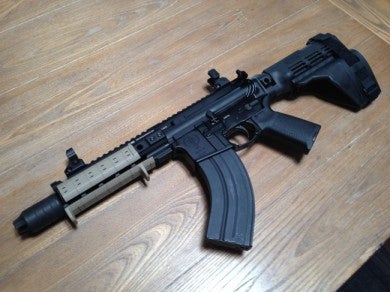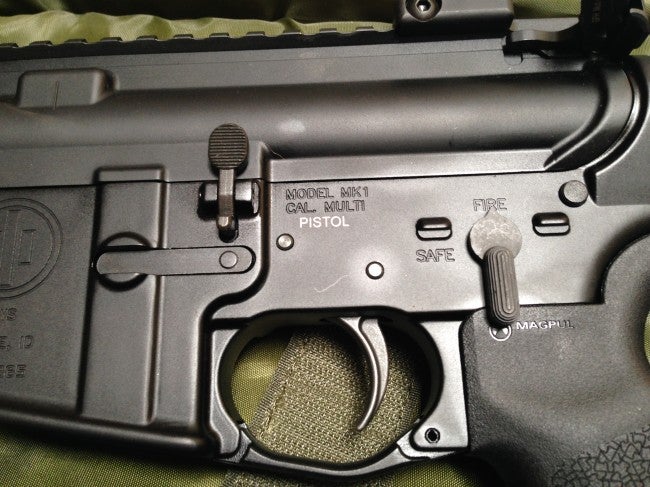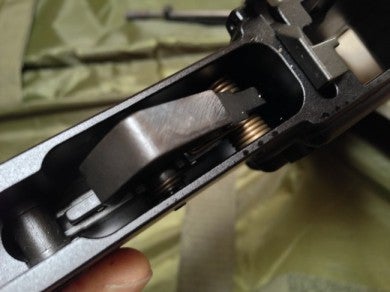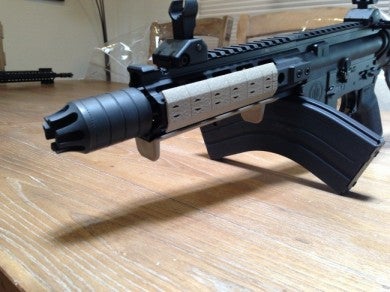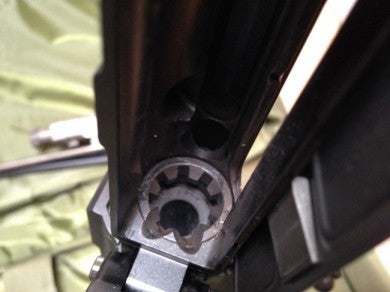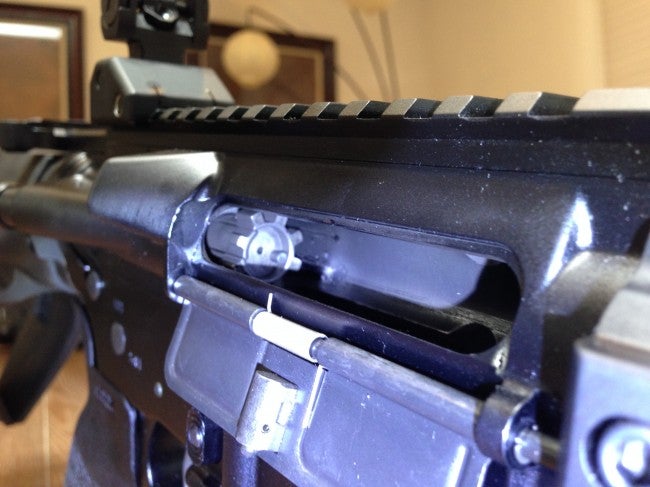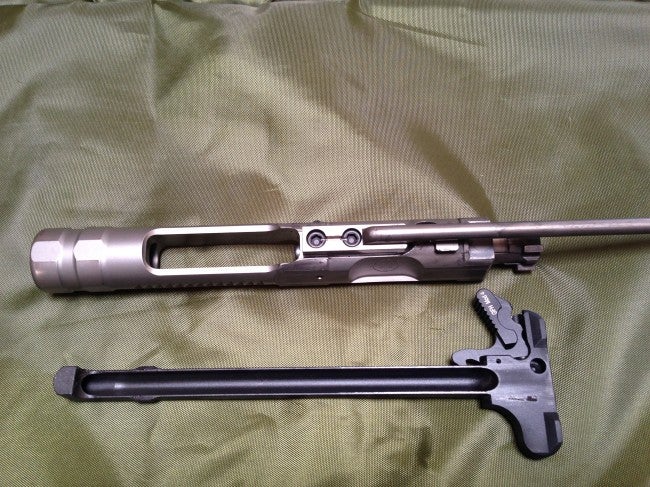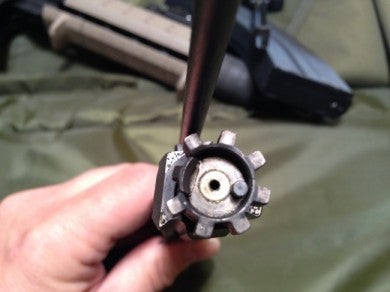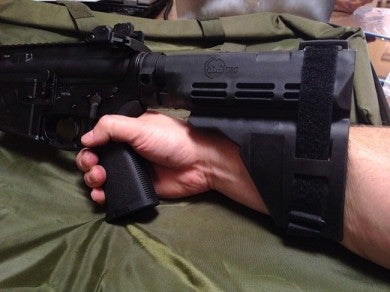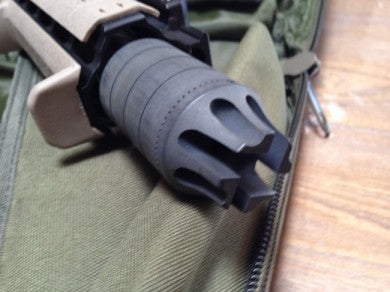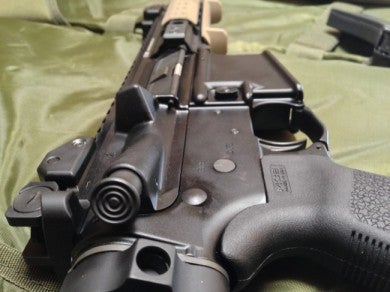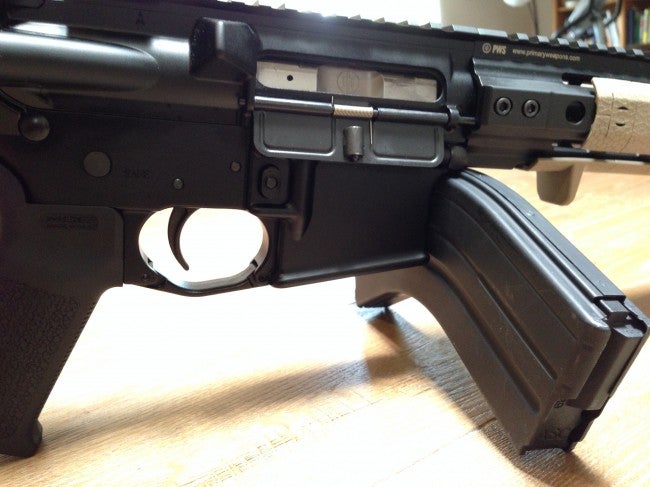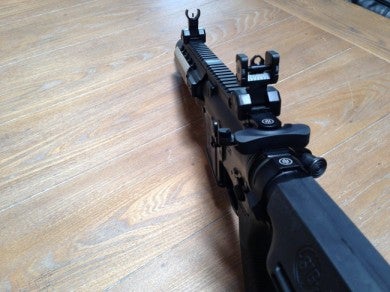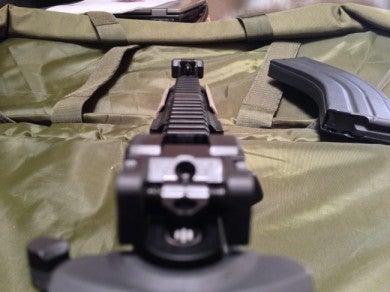Apparently the local gun shows are where I pick up many leads. A recent Saturday morning, I went with a couple of friends to the Gun Collectors of NM gun show. The show was smaller than normal, but I did my rounds anyway. BMC Tactical (the shop that did my most excellent stippling and polymer modifications, and is now, incidentally, doing my wife’s Glock 19) had their normal booth set up, front and center. I stopped by, and Walt (the owner) greeted me. He is normally super friendly (as are all of the employees), and this time was no different with the exception that he was excited about a couple of new products they had gotten in from Primary Weapons Systems.
The first one, he showed me, was Primary Weapons Systems’ first foray into making a Direct Impingement style AR (which I also got the opportunity to review–keep your eyes out for that). PWS is best known for their Long-Stroke Piston rifles (and this article is not intended to extoll the virtues of one platform over another).
The second one he showed me was the “Diablo”. Primary Weapons Systems had released this model around 2011 as a replacement for the venerable (but still well respected MP5). Rather than shooting a pistol round, though, this new contender fired .223 Remington, because nothing says love like high velocity rounds. Well, apparently, once PWS had proven this as a viable platform, a certain group of unnamed knuckle-draggers and door-kickers down range requested a version that had the ability to resupply a tad bit easier when away from normal supply lines. A few months of research and development later, and Primary Weapons System had a working model in 7.62x39mm that they produced in a pretty small run.
Well, as it turns out, this small run got “outed”. Someone, somewhere talked. Or a picture was taken. Or a psychic had a vision. Whatever the case, inquiries were made, and pressure was applied and PWS relented and did a run of them which they subsequently discontinued, mainly due to a lack of readily available and reliable magazines (the magazines at the time were just poorly made and hard to find). Like all awesome products, there was a high demand, and new availability of magazines convinced PWS to do another small run–only 250 units, and only as uppers. And BMC Tactical has one of the first. And they offered to not only let me fondle it lovingly, but to take it out for the weekend, and “run the **** out of it” (their words, not mine).
So “run the **** out of it” I did.
Construction
The model I got to play with was a 7.75″ upper mounted on a pistol lower. The platform is Primary Weapons Systems’ Long Stroke Piston, and is capable of fully automatic fire (they did not have an appropriate lower available, or this review may have ended prematurely with me slagging a barrel).
The overall weapon is short, solid and brutal. From the break on the front to the “AR” style banana magazine, everything about the Diablo screams well-made and overbuilt. It’s like an AK in AR skin…
It breaks down just like an AR, pop out the rear pin and it hinges forward. Pop out the front pin and detach the receiver. The charging handle and bolt carrier group slide out together and to separate those you have to rotate and remove the piston head allowing the charging handle to slide off the piston.
One thing I do want to point out is that this run from Primary Weapons System is JUST the upper. The model I got to demo had been assembled with components that are readily available and would likely be things you would do with the upper in any case. The three customizations that BMC Tactical made to the upper (beyond stock) were the installation of the PWS CQB muzzle device (the upper comes standard with the PWS Triad Series), addition of flip up sights, and the mounting of Noveske Polymer Panels.
Lower:
The receiver that was installed on my demo was the PWS Mark 1 Pistol Lower. It is marked “Cal. Multi” as it can run any standard AR upper with the corresponding box magazine. In this case the new availability of well constructed magazines from C Products Defense is one of the deciding factors that helped bring this platform back to market.
The trigger is a ALG Defense Quality Mil-Spec, and the action had a two position safety. The trigger was crisp, breaking the same every time, just as you would expect, and was set somewhere near 6lbs.
Also installed were both the Magpul trigger guard and Magpul pistol grip (with integral storage).
The Buffer Tube, machined from a single piece of 6061 T6 Extruded aluminum, is one of the nifty features. It has a lip that extends into the receiver and provides support against carrier tilt (which is important since this is a piston system). It has drain holes to prevent hydrolocking of the reciprocating buffer, and is fluted to shed debris. It uses a standard carbine length H2 buffer and spring. The tube uses a hex bolt to help align the tube to the lower receiver and two locking allen heads at the top to keep the buffer tube from rotating on the lower. If you are not familiar with the PWS buffer tube, what this boils down to is: No. More. Castle. Nut.
Upper:
The quad rail system is not proprietary and can be installed really on any AR platform. It is a modular quad rail; you can remove the rail without having to replace the entire component. The upper piece of the rail houses the shroud that contains the piston and the adjustable gas block, and that itself has a unique feature which is a special cutout to allow you to easily access (and thus adjust) the gas block.
“Adjustable gas block?” you ask. Yep. Primary Weapons Systems has a pretty nice four position adjustable gas block that is very easy to adjust (and also see what position it is in, thanks to some icons machined into the block). It works by restricting gases rather than venting out to the sides. The unused gases are then directed from the front of the gun. This system is designed to allow for a more reliable expulsion of gases that you can tune for whatever round you want to shoot, or brake you want to install. It was kind of strange to have an adjustable gas block on a piston system, because, well, that is kind of what the piston does. In this case it allows for really fine tuning the system. And with a 7.75 inch barrel you need all of the tuning you can get.
Bolt Carrier Group
The bolt carrier group looks just like one for an AR with the exception of being a tad bit larger. It disassembles exactly like an AR BCG though it is much more like the bolt assembly of an AK. If you compare it to the piston and bolt on an AK you will see the similarities–in this case the piston is affixed to the location where the gas key is normally attached. Obviously another benefit of the piston is that you don’t have to deal with the gas rings as in a normal Direct Impingement system. The Diablo has a free floating piston head that prevents binding in the sleeve where it rides and the piston head is also detachable for easy removal of the charging handle (they are linked together).
Remove the cotter pin and the firing pin comes right out.
The cam pin comes out just like a standard cam pin on an AR/M4/M16 allowing you to remove the bolt head.
The bolt face is opened a little bit for the bigger round as you would expect. The extractor is removed like on a standard AR bolt. I did pull the extractor after the shoot to see if there was wear and tear (at this point the Diablo had had less than 750 rounds total through it). The teeth on the extractor left nice sharp lines on my forearm (though my picture of that didn’t come out).
The charging handle is the BCM Gunfighter, one I personally think is one of the better ones out there (feel free to troll or support that opinion in the comments below).
Stock
The stock was the cheesiest part of it. It came with the Sig Sauer Arm Brace which is a “strap-your-arm-in-and-pretend-you-are-Ash-in-Army-of-Darkness” style. Some people may like it, but I found it to just be in the way. When you pull into your shoulder, it rotates. I tried shooting with my arm strapped in and was just not impressed. Don’t get me wrong, I normally love Sig products, but this stock was not my huckleberry. The only advantage to the stock is that it doesn’t trigger the BATFE for NFA control.
Furniture
It came with two flip up sights mounted on the full length top Picatinny rail (though the stock model ships slick–with no sights). The rail is mounted on the Primary Weapons Systems designed free floating hand guard, using the KeyMod system. The KeyMod allows for attaching a variety of accessories. In this case the system had the Noveske NSR Polymer Panel Set installed (thanks again to BMC Tactical).
Barrel
The barrel is the Primary Weapons Systems’ “standard” Isonite QPQ treated and feature a 1:8 twist.
Muzzle Device
The muzzle device installed on my demo was the PWS two-piece CQB model (as I mentioned before the stock model comes with the PWS Triad), and is much like a single baffle suppressor. You can unscrew the tip revealing a large chamber that contains the escaping gases. If you have ever done CQB operations with, say, an M4, you have likely experienced the concussive force that is released to the sides (annoying at the least, distracting at the worst). The PWS CBQ device allows the overpressure to blow forward, significantly reducing that potential distraction. The rear of the cap looks a lot like a “K” baffle. The front has a four prong design like some of the Vortex flash eliminator models (though much stubbier). Even though it has some of the traits of a suppressor it really didn’t reduce the sound at all. But it did help with the recoil.
Shooting
OMG. Fun. Normally I only shoot couple of hundred round total because, while I love you guys, I don’t have unlimited funds. But, as this was a special occasion, I broke out a can of 640 rounds to shoot. The crappiest part of my shoot was only having one magazine available (the shop had sold the other magazine they had at the gun show; though Luke informed me that they do have a large order coming in). The magazine is designed to hold 28 rounds, but I only loaded 20 per to make the math easier (and because I wanted to savor the experience).
I brought my wife and a couple of friends (including Thomas Gomez, another TFB writer), because shooting is always better in groups.
We shot from about 50 feet to 6 feet. The platform is designed to retain lethal capability out to about 200 meters. Not exactly what one would consider “Close Quarters”, so maybe it should be a MQB weapon? 🙂
I ran a couple of magazines through it to get a feel for how it shot, and the first thing I noticed (because you couldn’t miss it) was the ginormous fireball leaving the brake (I got a picture of that which is the featured image for this post). As you would expect, it was a bit loud.
I perceived very little recoil and even my wife (who I have a solid 120 pounds on) enjoyed shooting it. She actually wanted to know if we could buy it as it was her favorite gun of the day… Sadly, no.
We ran the gun as fast as we could load the magazine, and after about the 24th magazine, the weapon was getting too hot to hold unassisted, and I had to break out the gloves. One benefit is that as it got hotter, the fireball reduced. I’m assuming due to physics and not medical blindness. The heat did not appear to affect the Noveske grips.
Reliability
As I mentioned before, I ran 640 rounds of uber dirty Tula through it, and I did not clean, nor lubricate, the weapon once. Some of the rounds may have fallen in the dirt prior to being loaded in the magazine but I can neither confirm (nor deny) that fact.
Not once did I have a problem with feeding or round ejection with the 7.62x39mm rounds despite shooting in a couple of awkward positions, and while on the move. Even getting “too hot to hold” did not affect the Diablo.
I even let my buddy, a former Marine, handle it. My theory being that the only demographic group harder on equipment than Marines is firefighters (and I didn’t have a firefighter handy). Even he couldn’t stop us from a full course of fire during the day.
I can’t think of a single instance downrange (aside from training) where I would have asked a CQC weapon to perform like how I ran the Diablo during my review.
Conclusion
I think the Diablo is a well designed, and powerful, platform. The biggest problem with it is it’s rarity. If you encounter one in the wild, I highly recommend you take the opportunity to shoot it (or buy it if the funds are available). I’m very glad that my brothers down range are being given tools like this to better accomplish their missions. Weapons that are lighter, smaller, and easier to handle while packing a healthy punch (like that of 7.62x39mm) can only increase the disparity of force brought to the table, and thus, indirectly increase the safety of our forces.
Pros
Power in a small package
7.62 x 39mm
Long Stroke Piston (if you like pistons)
Adjustable Gas Block
Isonite QPQ Barrel
Cons
Limited run
Magazines are not super available (though are getting better so)
Long Stroke Piston (if you dislike pistons)
Ridiculous fireball
Sig Sauer Arm Brace
MANUFACTURER SPECIFICATIONS
Model Number: MK107UF0B
Action Type: Semi-automatic (Full auto available)
Caliber: 7.62x39mm
Capacity: 28 rounds (with the C Products Magazine)
Length: 23.75“
Barrel Length: 7.75” Isonite QPQ Treated
Weight: 5lbs, 4oz
Sights: Front Post, Rear Peep (both flip down)
Price: Street ~$1499
 Your Privacy Choices
Your Privacy Choices

